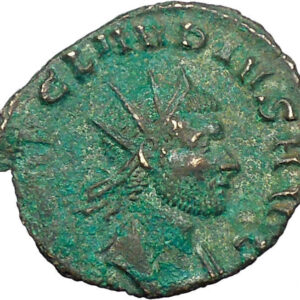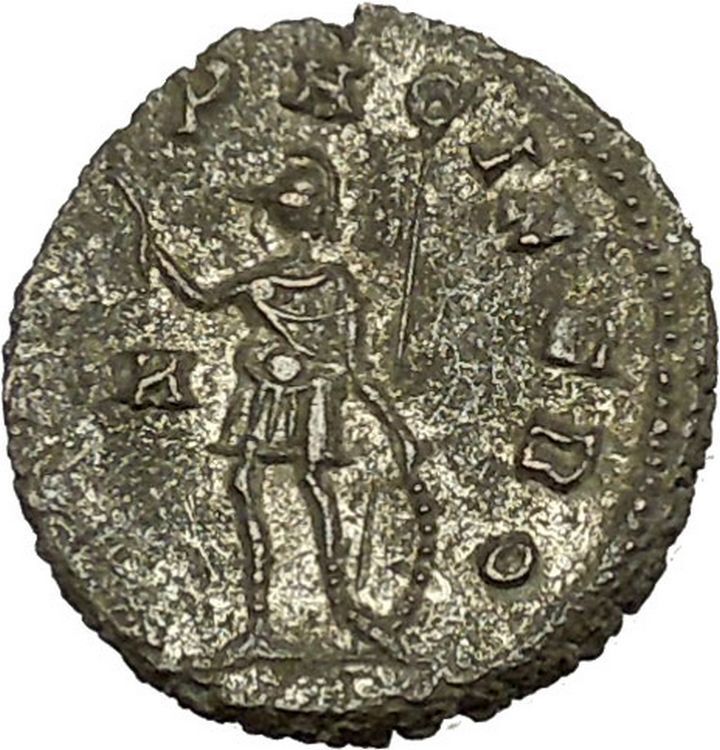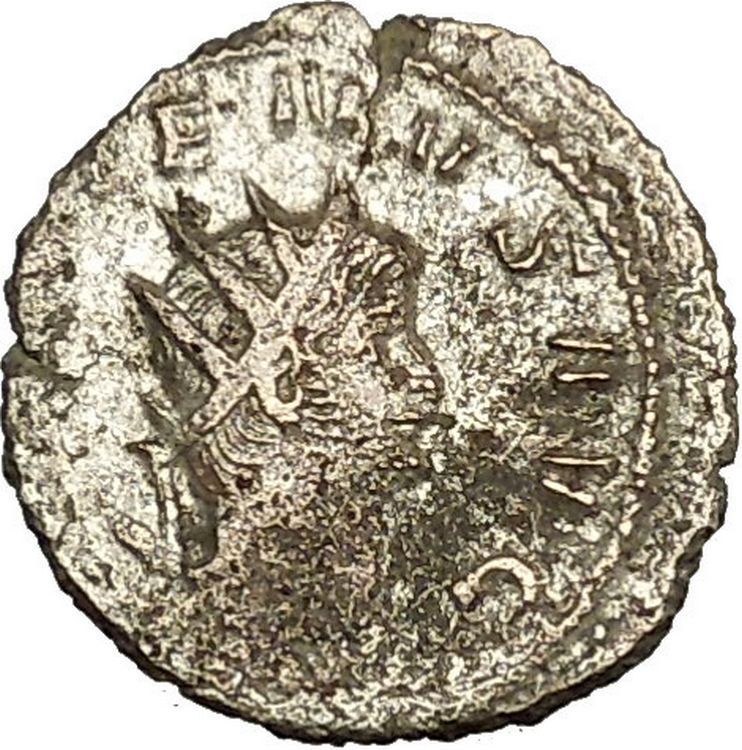|
Delmatius – Roman Caesar: 335-337 A.D. –
Bronze AE4 16mm (1.23 grams) Siscia mint: 335-336 A.D.
Reference: RIC 256 (Siscia), LRBC 758
FLDELMATIVSNOBC – Laureate, draped and cuirassed bust right.
GLORIAEXERCITVS Exe: BSIS – Two soldiers either side of one standard.
*Numismatic Note: The reverse legend dedicates this coin to “the glory of the
Army.”
You are bidding on the exact item pictured,
provided with a Certificate of Authenticity and Lifetime Guarantee of
Authenticity.
Standards

Roman military standards. The standards with discs, or signa
(first three on left) belong to centuriae of the
legion (the image does not show the heads of the standards – whether
spear-head or wreathed-palm). Note (second from right) the
legion’s
aquila
. The standard on the
extreme right probably portrays the
She-wolf
(lupa) which fed
Romulus
, the legendary founder of
Rome. (This was the emblem of
Legio VI Ferrata
, a legion then
based in
Judaea
, a detachment of which is
known to have fought in Dacia). Detail from Trajan’s Column, Rome

Modern reenactors parade with replicas of various legionary
standards. From left to right: signum (spear-head type), with
four discs; signum (wreathed-palm type), with six discs;
imago of ruling emperor; legionary aquila; vexillum
of commander (legatus) of
Legio XXX Ulpia Victrix
, with
embroidered name and emblem (Capricorn) of legion
Each tactical unit in the imperial army, from centuria upwards, had
its own standard. This consisted of a pole with a variety of adornments that was
borne by dedicated standard-bearers who normally held the rank of duplicarius.
Military standards had the practical use of communicating to unit members where
the main body of the unit was situated, so that they would not be separated, in
the same way that modern tour-group guides use umbrellas or flags. But military
standards were also invested with a mystical quality, representing the divine
spirit (genius) of the unit and were revered as such (soldiers frequently
prayed before their standards). The loss of a unit’s standard to the enemy was
considered a terrible stain on the unit’s honour, which could only be fully
expunged by its recovery.
The standard of a centuria was known as a signum, which was
borne by the unit’s signifer. It consisted of a pole topped by either an
open palm of a human hand or by a spear-head. The open palm, it has been
suggested, originated as a symbol of the
maniple
(manipulus = “handful”), the
smallest tactical unit in the
Roman army of the mid-Republic
. The poles were
adorned with two to six silver discs (the significance of which is uncertain).
In addition, the pole would be adorned by a variety of cross-pieces (including,
at bottom, a crescent-moon symbol and a tassel). The standard would also
normally sport a cross-bar with tassels.
The standard of a Praetorian cohort or an auxiliary cohort or ala was
known as a vexillum
or banner. This was a square flag,
normally red in colour, hanging from a crossbar on the top of the pole. Stitched
on the flag would be the name of the unit and/or an image of a god. An exemplar
found in Egypt bears an image of the goddess Victory on a red background. The
vexillum was borne by a vexillarius. A legionary detachment (vexillatio)
would also have its own vexillum. Finally, a vexillum
traditionally marked the commander’s position on the battlefield.[194]
The exception to the red colour appears to have been the Praetorian Guard, whose
vexilla, similar to their clothing, favoured a blue background.
From the time of
Marius
(consul 107 BC), the standard of all
legions was the
aquila
(“eagle”). The pole was surmounted
by a sculpted eagle of solid gold, or at least gold-plated silver, carrying
thunderbolts in its claws (representing
Jupiter
, the highest Roman god. Otherwise the
pole was unadorned. No exemplar of a legionary eagle has ever been found
(doubtless because any found in later centuries were melted down for their gold
content). The eagle was borne by the aquilifer, the legion’s most senior
standard-bearer. So important were legionary eagles as symbols of Roman military
prestige and power, that the imperial government would go to extraordinary
lengths to recover those captured by the enemy. This would include launching
full-scale invasions of the enemy’s territory, sometimes decades after the
eagles had been lost e.g. the expedition in 28 BC by
Marcus Licinius Crassus
against
Genucla
(Isaccea, near modern
Tulcea
, Rom., in the Danube delta region), a
fortress of the Getae
, to recover standards lost 33 years
earlier by
Gaius Antonius
, an earlier
proconsul
of
Macedonia
. Or the campaigns of AD 14-17 to
recover the three eagles lost by
Varus
in AD 6 in the
Teutoburg Forest
.
Under Augustus, it became the practice for legions to carry portraits (imagines)
of the ruling emperor and his immediate family members. An imago was
usually a bronze bust carried on top of a pole like a standard by an
imaginifer.
From around the time of Hadrian (r. 117-38), some auxiliary alae
adopted the dragon-standard (draco) commonly carried by Sarmatian cavalry
squadrons. This was a long cloth wind-sock attached to an ornate sculpture of an
open dragon’s mouth. When the bearer (draconarius) was galloping, it
would make a strong hissing-sound.
Decorations
The Roman army awarded a variety of individual decorations (dona) for
valour to its legionaries. Hasta pura was a miniature spear; phalerae
were large medal-like bronze or silver discs worn on the cuirass; armillae
were bracelets worn on the wrist; and
torques were worn round the neck, or on the cuirass. The highest
awards were the coronae (“crowns”), of which the most prestigious was the
corona civica, a crown made oak-leaves awarded for saving the life of a
fellow Roman citizen in battle. The most valuable award was the corona
muralis, a crown made of gold awarded to the first man to scale an enemy
rampart. This was awarded rarely, as such a man hardly ever survived.
There is no evidence that auxiliary common soldiers received individual
decorations like legionaries, although auxiliary officers did. Instead, the
whole regiment was honoured by a title reflecting the type of award e.g.
torquata (“awarded a torque”) or armillata (“awarded bracelets”).
Some regiments would, in the course of time, accumulate a long list of titles
and decorations e.g. cohors I Brittonum Ulpia torquata pia fidelis c.R..
Flavius Dalmatius (died 337), also known
as Dalmatius Caesar, was a
Caesar
(335-337) of the
Roman
Empire
, and member of the
Constantinian dynasty
.
Dalmatius was son of another
Flavius Dalmatius
,
censor
, and nephew of
Constantine I
. Dalmatius and his brother
Hannibalianus
were educated at
Tolosa
(Toulouse) by rhetor
Exuperius
.
On
19
September
335
,
he was raised to the rank of Caesar, with the control of
Thracia
,
Achaea
and
Macedonia
. Dalmatius died in late summer 337, killed by his own soldiers. It
is possible that his death was related to the purge that hit the imperial family
at the death of Constantine, and organized by
Constantius II
with the aim of removing any possible claimant to the throne.
|










